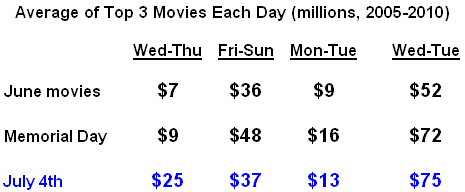>
As a baseline, we looked at the four or five weeks of June (between the atypical Memorial Day and July Fourth weeks). We focused on the top three movies each weekend, usually one or two opening films and one or two strong returning films. In June, the average top three film generates $12 million on Friday, bumps up 13% to $13 million on Saturday, and then declines gently to $10 million on Sunday. (The index values in blue in the table below simply refer to the percentage of Friday business each day represents — for example, in June, Sunday is 88% of the Friday level.)
On Memorial Day, the average top three film goes up to $16 million on Friday (versus $12 million in June), but the big change involves the patterns of business on subsequent days. The Saturday bump is not as high on Memorial Day weekend (up 7% from Friday) as June (up 13%). Sunday’s number on Memorial Day weekend is almost as high as Friday’s tally, while Monday (Memorial Day itself) is fully 75% of the Friday number (way up from 40% for Mondays in June). By Tuesday, movie-goers are exhausted, and the day after the holiday is actually a little lower than Tuesdays in June. Over this five-day period, top performing films average almost $20 million more in box office than June movies do. Basically, Sunday almost becomes another Friday, and Monday becomes a strong Sunday. These patterns for Memorial Day are very consistent year to year and serve as a good proxy for other four-day weekends such as MLK Day, President’s Day and Labor Day.
But what about the Fourth of July? The question is much more complicated as the Fourth is the rare holiday tied to a date and not a day of the week — so there is no fixed pattern. No matter where the Fourth falls, however, the box office lift tends to stretch across about a six-day period, almost a full week of strong box office activity. Although there are exceptions, think of Fourth of July week as starting Wednesday before July 4 and extending through Monday. This year the holiday itself falls on Monday, and the last time this happened was 2005 (War of the Worlds, anyone?) and before that all the way back in 1994.
The table below summarizes box office activity for a Wednesday-Tuesday week for our June baseline, Memorial Day and July Fourth. Interestingly, the same number of dollars are available July Fourth as Memorial Day (around $75 million for a top performing film) — but the dollars are spread more evenly across the week of Independence Day. The Friday-Sunday portion of July Fourth week is actually identical to a normal weekend in June, while there is a huge pop in the Wednesday-Thursday opening period and a moderately strong Monday-Tuesday follow-up (somewhere between Memorial Day and June levels).
Of course, Transformers: Dark of the Moon should dominate this Independence Day week. For comparison, the first two movies in the series also opened around this period (the original during July Fourth week and the second film during the week before the holiday). These are their daily tracks (in millions of dollars):
Transformers (2007) Tuesday July 3 $36.6, Wednesday July 4 $29.1, Thursday July 5 $19.2, Friday July 6 $22.6, Saturday July 7 $25.7, Sunday July 8 $22.1, Monday July 9 $9.9
Transformers: Revenge of the Fallen (2009) Wednesday June 24 $62.0, Thursday June 25 $29.1, Friday June 26 $36.7, Saturday June 27 $40.2, Sunday June 28 $32.0
War of the Worlds (the last major film to open with July 4 on a Monday) opened Wednesday June 29 with $21.2, dropped to $14.4 Thursday, then bounced back to $21.9 on Friday July 1, $23.2 on Saturday and $19.8 on Sunday. By July 4 itself on Monday, the movie ended the holiday period quietly with $12.2. This 38% decline from July 3 to July 4 is large by historical standards. Most top films drop around 20-25% on July 4 when attention turns to the BBQ during the day and fireworks in the sky at night. As a side note, Americans are certainly not watching television on July 4, which year in and year out is the least viewed night of the year along with Christmas Eve.
Speaking of Christmas, when we are closer to the holidays we will take a look at box office patterns for Thanksgiving, Christmas and New Year’s, particularly the all-important week after Christmas when no new movies are released usually but each day has the potential for Friday or Saturday levels for the holdover films. But let’s get through the summer first.






